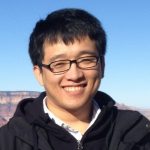
UW Chemistry’s Max Friedfeld, Daniel Kroupa, and Jian Wang will each receive $10k in Unfettered Research Grants
July 18, 2018
Washington Research Foundation Postdoctoral Fellow Max Friedfeld and Washington Research Foundation Innovation Postdoctoral Fellows in Clean Energy Daniel Kroupa and Jian Wang have been awarded Mistletoe Research Fellowships for the 2018-19 academic year. The Mistletoe Foundation builds bridges between the academic, entrepreneurial, and civil communities to create a more human-centered and sustainable future through technology. As part of the fellowship, awardees receive a $10,000 Unfettered Research Grant that can be applied to almost any university-approved research-related activity.
Friedfeld, a member of chemistry professor Brandi Cossairt’s group, researches the growth of quantum dots (QDs), which are semiconducting nanocrystals with a wide range of optoelectronic properties and high-tech applications. One such application is next-generation TV and display devices: QD displays can achieve up to a 30% increase in the spectrum of available colors while using 30 to 50% less power than LCD TVs. However, today’s commercial products often rely on cadmium-containing materials that are relatively toxic, so Friedfeld has explored QDs made of an alternate material: indium phosphide (InP). He is developing a new flow-based synthesis method for InP QDs that will grant access to greater control over the reaction, allowing for uniform QD growth and modification of InP QDs while taking less time, resulting in higher yields, and generating less waste than batch InP QD synthesis.
To develop the technique, Friedfeld will utilize the Vapourtec V-3 pump flow reactor at the Washington Clean Energy Testbeds. Because the Testbeds already own this crucial piece of equipment, Friedfeld can use the Mistletoe funds to purchase auxiliary equipment and material supplies for his research. He ultimately wants to commercialize this technique, with the aim of improving upon today’s industrial-scale manufacturing of QDs for displays and other applications.
As a member of both Professor Cossairt and chemistry professor Daniel Gamelin’s research groups, Kroupa researches metal-halide perovskites, which have received considerable attention for next-generation solar cells due to low material and manufacturing costs and comparable performance to traditional silicon cells. Kroupa has found that selectively adding ytterbium ions (Yb) to cesium lead halide perovskites (CsPbX3) results in a unique phenomenon known as quantum cutting. Quantum cutting occurs when a single high-energy photon is converted into multiple lower-energy photons by a semiconducting material, due to quantum effects.
Using the facilities at the Washington Clean Energy Testbeds, Kroupa’s goal is to harness this property by coating conventional silicon solar cells with a layer of quantum-cutting perovskite. In conventional solar cells, a single photon can only excite a single electron. However, by converting extra energy from high-energy photons into additional low-energy photons that excite additional electrons, Kroupa’s perovskite layer could create a dramatic increase in efficiency at low cost.
 Wang’s research in CEI Chief Scientist and chemistry professor David Ginger’s group focuses on an existential challenge for organic photovoltaics: converting heat losses into usable voltage. Organic photovoltaics are a low-cost and flexible alternative to other photovoltaic technologies. However, current device configurations are susceptible to large voltage losses in the form of non-radiative recombination, which occurs when the energy from a photoexcited electron is lost into the surrounding atoms as vibration.
Wang’s research in CEI Chief Scientist and chemistry professor David Ginger’s group focuses on an existential challenge for organic photovoltaics: converting heat losses into usable voltage. Organic photovoltaics are a low-cost and flexible alternative to other photovoltaic technologies. However, current device configurations are susceptible to large voltage losses in the form of non-radiative recombination, which occurs when the energy from a photoexcited electron is lost into the surrounding atoms as vibration.
 These losses often occur due to the use of fullerenes — large, geometric carbon molecules similar to graphene and carbon nanotubes — as the material that accepts excited electrons, so Wang is developing an understanding of non-fullerene acceptors. A guideline to avoiding non-radiative recombination would be invaluable for chemists trying to synthesize new materials for advanced organic photovoltaics. By integrating non-fullerene acceptors, Wang hopes to push forward the commercialization of organic photovoltaics.
These losses often occur due to the use of fullerenes — large, geometric carbon molecules similar to graphene and carbon nanotubes — as the material that accepts excited electrons, so Wang is developing an understanding of non-fullerene acceptors. A guideline to avoiding non-radiative recombination would be invaluable for chemists trying to synthesize new materials for advanced organic photovoltaics. By integrating non-fullerene acceptors, Wang hopes to push forward the commercialization of organic photovoltaics.
In a letter to awardees, Mistletoe wrote, “It is our belief that unfettered research—without pre-negotiated deliverables—is necessary to produce the kinds of scientific and technological advances with the potential to change the world.”







